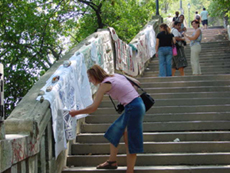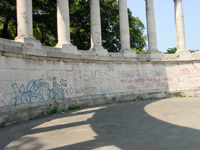Gellert Hill

Saint Steven (Szent Istvan in Hungarian, if memory serves) was a bishop who, in the 9th century (again, if memory serves) helped Christianize Hungary. He was not well received by local pagans. After all, he was trying to change their religion, something most people don’t like – a fact that many missionaries seem to forget. After the king (which? the name escapes me) died and Steven had no one to protect him, the pagans took him up to the top of a large hill in Buda, stuffed him in a barrel, and rolled the barrel down the hill. According to legend, anyway.

The most prominent feature of Gellert Hill is the statue of Saint Steven, which, of course, has been been graffiti-ized (and not even vaguely artistically, either). Additionally, there is the Statue of Freedom at the very top. A winding path, along which you can buy various goods, leads to the top.
Lastly, as to why it’s called “Gellert Hill” and not “Saint Steven’s Hill” is something I never found out.

Saint Steven’s Basilica

As mentioned before, Saint Steven went from villain to hero for the majority of Hungarians as Christianity replaced paganism in Hungary and Hungary turned Saint Steven into a national hero.
Such a national hero that his right hand is kept in a back chapel in the basilica . . .
The basilica was completed just after the Parliament building and has the exact same height of 96 meters – an effort by the designers not to architecturally usurp the secular authority. K laughed, “In Poland, they would have made it higher on purpose!”
After a lunch break, we returned to the basilica and walked up 300+ stairs (I can’t recall the exact number, but I, like the dork I am, counted them) to the base of the dome.
View pictures of the interior and shots from the dome.
Hungarian Oddities
Hungarian is an odd-ball language. I don’t mean that insultingly, but factually, for it is completely unrelated to any of the languages of neighboring counties, and only somewhat related to Finnish (!?!).
For a Pole, it’s particularly odd even at first glance. “Sz” in Polish is pronounced “sh” and “s” is pronounced like, well, “s.” In Hungarian, though, it’s just the opposite: “sz” = “s” and “s” = “sh.”
Another odd thing: names. Hungarians say their last name first in most situations, so I would introduce myself as and have on my business card “Scott Gary.” (Those familiar with the film The Usual Suspects will remember that the old Hungarian man in the hospital bed says at first only “Kaiser Szoze” (can’t recall the spelling). This is a mistake, for a real Hungarian would be muttering “Szoze Kaiser.”)

